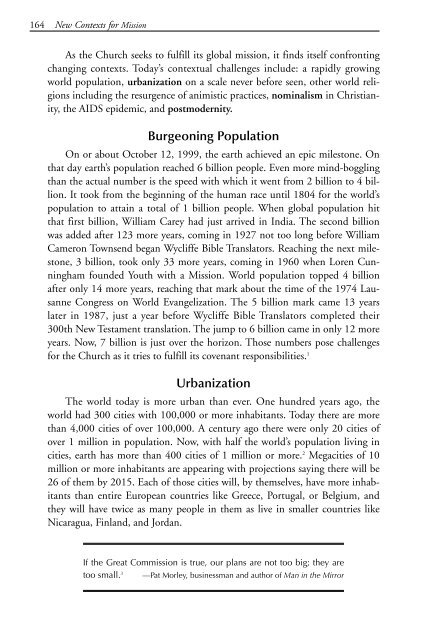discovering missions - Southern Nazarene University
discovering missions - Southern Nazarene University
discovering missions - Southern Nazarene University
You also want an ePaper? Increase the reach of your titles
YUMPU automatically turns print PDFs into web optimized ePapers that Google loves.
245187 Disc Missions ins 9/6/07 1:04 PM Page 164<br />
164 New Contexts for Mission<br />
As the Church seeks to fulfill its global mission, it finds itself confronting<br />
changing contexts. Today’s contextual challenges include: a rapidly growing<br />
world population, urbanization on a scale never before seen, other world religions<br />
including the resurgence of animistic practices, nominalism in Christianity,<br />
the AIDS epidemic, and postmodernity.<br />
Burgeoning Population<br />
On or about October 12, 1999, the earth achieved an epic milestone. On<br />
that day earth’s population reached 6 billion people. Even more mind-boggling<br />
than the actual number is the speed with which it went from 2 billion to 4 billion.<br />
It took from the beginning of the human race until 1804 for the world’s<br />
population to attain a total of 1 billion people. When global population hit<br />
that first billion, William Carey had just arrived in India. The second billion<br />
was added after 123 more years, coming in 1927 not too long before William<br />
Cameron Townsend began Wycliffe Bible Translators. Reaching the next milestone,<br />
3 billion, took only 33 more years, coming in 1960 when Loren Cunningham<br />
founded Youth with a Mission. World population topped 4 billion<br />
after only 14 more years, reaching that mark about the time of the 1974 Lausanne<br />
Congress on World Evangelization. The 5 billion mark came 13 years<br />
later in 1987, just a year before Wycliffe Bible Translators completed their<br />
300th New Testament translation. The jump to 6 billion came in only 12 more<br />
years. Now, 7 billion is just over the horizon. Those numbers pose challenges<br />
for the Church as it tries to fulfill its covenant responsibilities. 1<br />
Urbanization<br />
The world today is more urban than ever. One hundred years ago, the<br />
world had 300 cities with 100,000 or more inhabitants. Today there are more<br />
than 4,000 cities of over 100,000. A century ago there were only 20 cities of<br />
over 1 million in population. Now, with half the world’s population living in<br />
cities, earth has more than 400 cities of 1 million or more. 2 Megacities of 10<br />
million or more inhabitants are appearing with projections saying there will be<br />
26 of them by 2015. Each of those cities will, by themselves, have more inhabitants<br />
than entire European countries like Greece, Portugal, or Belgium, and<br />
they will have twice as many people in them as live in smaller countries like<br />
Nicaragua, Finland, and Jordan.<br />
If the Great Commission is true, our plans are not too big; they are<br />
too small. 3 —Pat Morley, businessman and author of Man in the Mirror

















